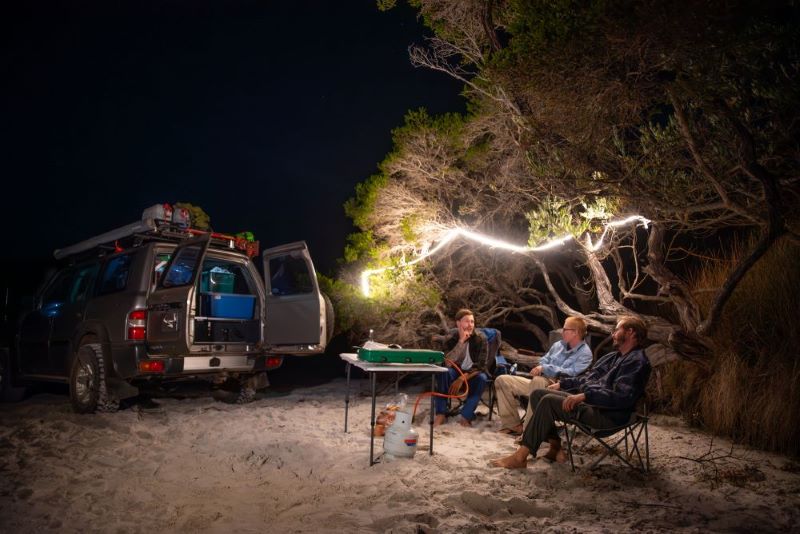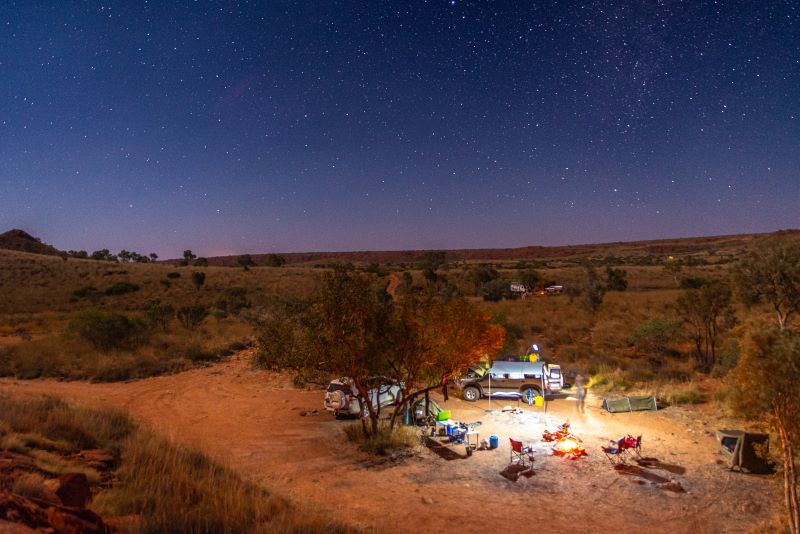Best Camping Light Solutions
Overview
Great camp lighting means the fun doesn’t end when the sun goes down. Whether you camp with a tent, caravan, swag, or a camper trailer; our goal today is to get you up to speed on lights for camping in any situation.

Why proper lighting is important for camping?
The campfire will always be our favourite source of light (and warmth). But what happens when you move a few metres away? Or when you’re not allowed a campfire at all? You’re here for a camping trip, not a stumble and trip! So you’ll need a personal light around the campsite. You’ll want a fixed light source to cook under, tent lights that can also suit a swag, and possibly a broad area light like a camping lantern, which is dimmable to suit the mood.
Different types of lights for camping
Camping Lantern
The lantern format has been around forever for good reason. A camping lantern is perfect to light the communal camp area. It can be positioned away from your vehicle, caravan, or tent and throws a 360 degree spread of light. Many lanterns have a hook so you can get them up high for an even better spread of light. Today’s camping lanterns are rechargeable camping lights and all LED. They are brighter and tougher than old fuel lanterns and pose no risk of burning people or starting a fire.
Work Lights
Some LED work lights which are designed for working on the car actually do a pretty good job lighting up the campsite as well. These often have magnetic backs and bases, great for sticking to a vehicle or camper, or hanging from a gazebo, awning, or tree. With a spread of light between about 120 and 180 degrees, you’ll get good light coverage and intensity over the area.
Head Torches
However you camp, a head torch should be on your person at all times. Wherever you look, there will be light! It’s ideal for those busy times moving around camp when you need your hands from setting up in the dark, to cooking a meal or just strolling to the dunny and back. Choose one with rechargeable or replaceable batteries and multiple brightness modes. They’re easily some of the best lights for camping.
Hand Torches
After hyping up the head torch you might think the hand torch is out of date, but a torch for camping still has a place. If you love long strolls at night or wildlife spotting, you’ll get unmatched power and distance from a hand torch. Plus longer run time than a head torch, as more battery capacity can be implemented. On some handheld torches you’ll even find multifocal lenses so you can switch between maximum distance and full spread.
LED Strip Lights
LED strip lights are some of the best camp lights today. They don’t typically contain batteries and are designed to be powered from your car, caravan, camper trailer or a portable battery pack. LED strip lights can be purchased as hard-backed with Velcro ties to hold them in place, or flexible on a roll up to 5 metres long that can be strung around camp. LED strip lights are best installed in areas you frequently need lots of light such as under a gazebo or awning. Of all the lighting options, they typically output the most light because they don’t rely on small inbuilt batteries. For lights that don’t attract bugs, LED strip lights with orange light mode are your best choice.

Tips for choosing the best camping lights for your trip
To summarise what we’ve learned about lights for camping, here are a few common camping scenarios with the best camping lights to match each.
1. Lighting a tent or swag
Inside a swag where there is typically not much space, a head torch will do fine. Larger tents usually feature a hook in the middle of the roof, a small lantern works especially well here.
2. Lighting a communal area
Communal areas such as around the fire or a picnic table, away from your vehicle or trailer; are best lit with a camping lantern. Work lights are also a suitable choice.
3. Cooking area
Portable work lights are also a good choice to light your cooking area. If you’re moving between a kitchen or bench and the campfire often; you’ll also find great value in a head torch for camping.
4. Gazebo or awning
Under a gazebo or awning you’ll typically want lights that don’t attract bugs, and have a high output which is also dimmable. LED strip lights are probably the best choice, followed closely by a camping lantern.
5. Personal lighting
For moving around the campsite, everyone should have a head torch. If you like to throw some distance to spot wildlife from time to time, it’s also worth keeping a handheld torch for camping handy.

FAQs
How long do camping lights typically last?
As far as longevity goes, you’re unlikely to see an LED camping light fail. Inbuilt rechargeable lithium batteries have a lifespan of up to 1000 charge cycles, and the LEDs themselves will last up to 50,000 hours.
If we’re talking about how long camping lights typically last on a single charge; that depends on the light. A head torch contains less battery power, and will usually run around 4 hours on high. Lanterns, work lights, and handheld torches have larger batteries and can run for 10 to 20 hours on high brightness.
Lights powered by an external battery will go as long as that battery has charge.
How many lumens do I need for a camping light?
The number of lumens needed for a camping light is different for each light type. For a head torch, usually 200-400 lumens is plenty. A camping lantern should fall between 500 to 1000 lumens. For the handheld torch, the brighter the better. A few thousand lumens will give you excellent beam distance.
What camping lights don’t attract bugs?
Orange camping lights are the best choice if you want to keep bugs at bay. The warmer the light however, the less bright it will be. So if keeping bugs away from your camping lights is a priority; try to choose lights which can be switched between orange and white modes.
If it's getting dark or raining, which lights should you use?
If it’s getting dark, any light is better than none! But if you have an important task to complete, try and choose a camping light which is nice and bright. For rainy situations, your lights for camping must ideally be waterproof, or at least water resistant. Water resistance is measured with an ingress protection rating (IPXX). An IPX6 rating or higher will be suitable for use in the rain.
*Important information* - Click here to read more about our DIY Advice Terms and Conditions.